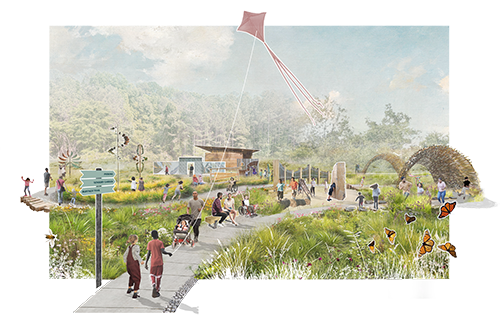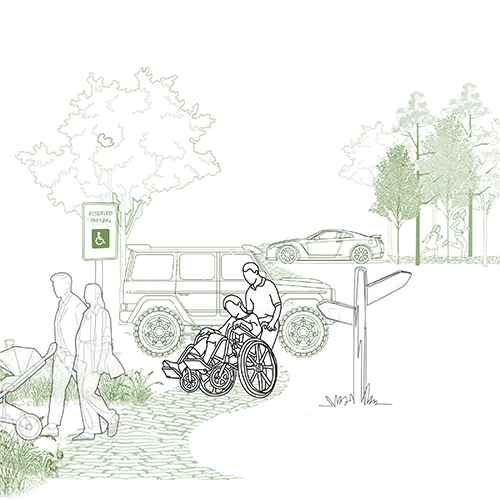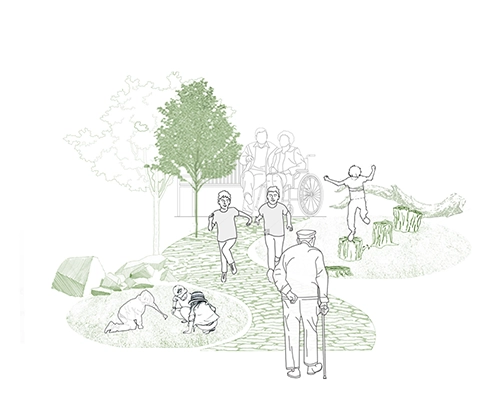.webp)
.webp)
.webp)
Nature for Everyone: Why Accessible Greenspaces are Vital to Our Health
On your hike, you may encounter wildflowers, butterflies, or see deer, rabbits, or a myriad of other creatures who live in the wild. Before long, your mood shifts. Maybe the worries you carried into the park with you are far from your mind, and you feel your senses start to come alive as they continue to more deeply engage with the wondrous world around you.
How Nature Supports Health and Well-being

Forest bathing, earthing, blue space therapy, labyrinth walking, and even the simple act of looking at trees may seem like unconventional treatments for a host of illnesses, yet a wide and comprehensive range of institutionally supported studies demonstrate that access and exposure to nature provide numerous benefits to our mental, physical, and emotional health. Positive impacts of nature exposure range from preventative (lower cancer rates in those with regular exposure) to curative (reversing symptoms and speeding recovery from illness.)
A review of more than 950 studies published in The Journal of Global Health shows the health benefits of time spent in nature.
Reduced cortisol levels, reduced inflammation, improved cardiovascular health, increased vitamin D production and synthesis for better blood and bone health, and increased immunity—these are just some of the physical benefits. And being outdoors supports mental health through better sleep, longer attention spans, and lowered stress and emotional reactivity. Emotional wellness is supported by the social opportunities of outdoor recreation, as well as building confidence through engaging in outdoor activities.
The Reality of Access to Greenspaces
But we can’t take the availability of greenspaces for granted.
Increasingly, we are moving into more urban environments. Half of the earth’s population resides in cities. Large areas of land are lost to housing and commercial development. Concrete and steel have replaced the native habitats that we are biologically designed to live among. Our daily lives have been pushed further indoors, our workdays spent in front of screens, under fluorescent lights. After hours, most of us continue our screentime, binge-watching television shows or endlessly scrolling on our phones. As a result, access to nature is becoming ever more crucial to help us disconnect from technology and reconnect with the benefits of connecting with the natural world.
Community Roots in Conservation
The members of our community have been championing the need for access to nature since the 1970s. Ruffner Mountain was saved in 1977, when area residents banded together to stop a proposed high-rise apartment complex. In the 1990s, Pinson area residents joined together to stop the development of a proposed jail and helped to establish the beautiful Turkey Creek Nature Preserve. In the early 2000s, Freshwater Land Trust worked alongside community members, who formed a Friends of Red Mountain group, to help establish Red Mountain Park, a 1,200-acre park on the former mining site. At the heart of Jefferson County Greenways’ work is providing access to these beautiful natural spaces for recreation, health, and social connection.
Strengthening Greenspaces through Public-Private Partnership
Jefferson County Greenways was established as a public-private partnership to better address the needs of our community. Prior to 2023, all three of Jefferson County’s large acreage greenspaces - Red Mountain Park, Ruffner Mountain, and Turkey Creek Nature Preserve - were managed by independent nonprofit organizations. This left our greenspaces competing for limited private funds. Additionally, Jefferson County lacked a dedicated parks & recreation department, leaving maintenance and oversight of these spaces to nonprofit employees who were often wearing multiple hats in their roles.
In 2023, with the sponsorship of Senator Merika Coleman and Representative Rolanda Hollis, House Bill 336 was signed into law, creating the Jefferson County Greenways Commission, a public entity supported by public funds from the State of Alabama, Jefferson County, and area municipalities to ensure this critical public infrastructure was being supported by public funds, making maintenance of these greenspaces a public service provided to our residents and park visitors. Following that, the existing nonprofits merged to form Jefferson County Greenways Foundation to help further the mission of our public greenspaces, providing the enriched public programming, research, and conservation efforts that make these places so special to our community.

The strength of this public-private partnership enabled our organization to focus on improving greenspace accessibility across our county. Since then, we have been evaluating how best to serve the population of Jefferson County through our greenspaces, increasing the number of people who are able to use and enjoy our natural areas, as well as improving the outcomes of visitor experience.
In 2020, at the height of the pandemic, outdoor recreation numbers soared as we sought safe places for social activities, helping to spring us from the confines of our homes. It was during this time that the calls came to Red Mountain Park, Ruffner Mountain, and Turkey Creek Nature Preserve, with questions like, “What trail can I take my child in a stroller?” “Which trails in your park are wheelchair accessible?”
Too often, individuals experience insurmountable hurdles to reaping the benefits of nature exposure. Many green spaces, trail systems, and preserve areas were established without consideration of persons with disabilities, whether they are physical, cognitive, or sensory, temporary or lifelong. As a result, these people are excluded from enjoying the numerous positive impacts of nature exposure.
The rugged terrain of most natural spaces creates a major barrier to access. Individuals with disabilities, young parents with infants in strollers, medically fragile, seniors, and those with limited or no outdoor experience, making it impossible to experience the myriad benefits that nature has for our health and wellness.
In addition to a lack of appropriate infrastructure, people with disabilities face social barriers and a general lack of inclusivity or intentionality, whether through a lack of resources such as universally accessible restrooms or signage, or websites that don’t inform users of what to expect at a park or preserve when they arrive. Accessing information about accessible parking, restrooms, sensory resources and even access points for transportation to get to our community’s nature spaces can feel daunting, and may discourage large groups of people from pursuing outdoor activities or visiting community green spaces.
Currently, we are undergoing a deep evaluation to make each of our large acreage greenspaces more welcoming and easy to access. At Red Mountain Park, we are constructing universally accessible restrooms at the Frankfurt Road Entrance. At Ruffner Mountain, we are improving the accessible decking guests use to enter our Nature Center, as well as planning trail improvements to help first-time visitors feel more welcome and at ease. At Turkey Creek Nature Preserve, we need a step-free, ADA path to The Falls.
Designing for Inclusion from the Ground Up
.webp)
What is truly needed, however, is a space that is not simply retrofitted to meet the wide-ranging needs of park visitors, but rather, is built from the ground up with whole families in mind. East Side Park is a six-and-a-half-acre greenspace located conveniently off of Interstates 59and 459 and Highway 11 in Eastern Birmingham, with close proximity to Trussville, Irondale, Centerpoint, Pinson, and Clay. The park will feature universally accessible trails, restrooms, and parking, and will be planted entirely with plants native to Central Alabama’s five ecoregions - Woodland, Mixed Forest, Savannah, Prairie, and Wet Prairie - much of which is propagated and grown in the greenhouses located at Ruffner Mountain and Turkey Creek Nature Preserve.
Jefferson County Greenways has partnered with disability inclusion organizations across our service area, including United Ability, Lakeshore Foundation, Glenwood, Alabama Institute for the Deaf & Blind, Disability Rights & Resources, and UAB. We teamed up with Hoerr Schaudt Landscape Architects to design an award-winning park that is truly inclusive and accessible, relying on their expertise and design partner Ingrid Kanics, who is a landscape architect, part- time wheelchair user, and occupational therapist, to ensure we deliver on this promise.

This park, funded by the City of Birmingham, EBSCO, Jefferson County Department of Health, the Junior League of Birmingham, Community Foundation of Greater Birmingham, and numerous private funders, will provide programming that is fully inclusive of individuals regardless of their age or ability. Whether you live with a disability, are medically fragile, area senior, or have young children in strollers, East Side Park will ensure that the birdsong, the landscape, the creatures, and the numerous benefits associated with exposure to nature will be available to you.
Construction for the park will break ground in early 2026, with completion slated by no later than the following December.
Your Support Can Help Make this Vision a Reality
To deliver this incredible promise to our community, we need your help. To find out how you can support this park’s development, visit East Side Park
Written by: Janet Simpson, JCG Chief Operating Officer & Deputy Director












